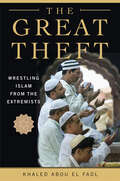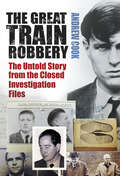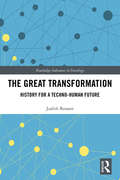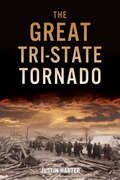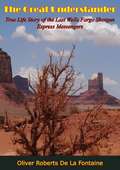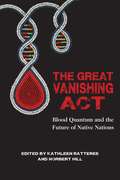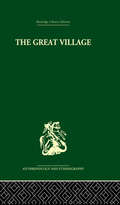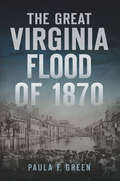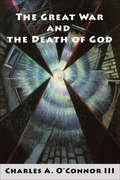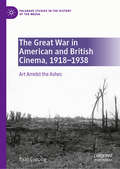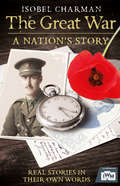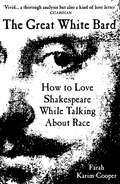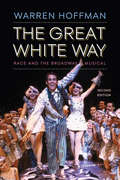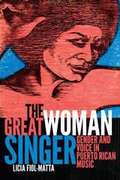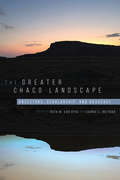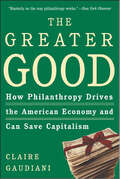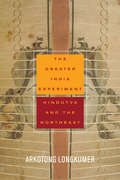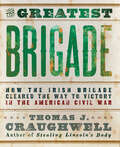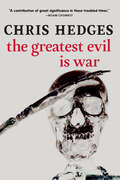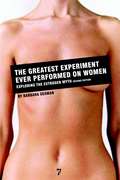- Table View
- List View
The Great Theft: Wrestling Islam from the Extremists
by Khaled Abou El Fadl“Those looking for an understanding of the Muslim world and its relationship to the West . . . will find this book invaluable” (Dallas Morning News).The Great Theft is an impassioned defense of Islam against the encroaching power of extremists. Khaled Abou El Fadl, one of the world’s preeminent Islamic scholars and an accomplished Islamic jurist, roots his arguments in long-standing historical legal debates, delineating point by point beliefs and practices of moderate Muslims and distinguishing these texts from the corrupting influences of extremists. From the role of women in Islam to the nature of jihad, and from democracy and human rights to terrorism and warfare, Abou El Fadl builds a vital vision for a moderate Islam. At long last, all who oppose extremism have a desperately needed voice to help reclaim Islam’s great moral tradition.
The Great Train Robbery: The Untold Story from the Closed Investigation Files
by Andrew CookThe Great Train Robbery of 1963 is one of the most infamous crimes in British history. The bulk of the money stolen (equivalent to over £40 million today) has never been recovered, and there has not been a single year since 1963 when one aspect of the crime or its participants has not been featured in the media. Despite the wealth and extent of this coverage, a host of questions have remained unanswered: Who was behind the robbery? Was it an inside job? And who got away with the crime of the century? Fifty years of selective falsehood and fantasy has obscured the reality of the story behind the robbery. The fact that a considerable number of the original investigation and prosecution files on those involved and alleged to have been involved were closed, in many cases until 2045, has only served to muddy the waters still further. Now, through Freedom of Information requests and the exclusive opening of many of these files, Andrew Cook reveals a new picture of the crime and its investigation that, at last, provides answers to many of these questions.
The Great Transformation of Japanese Capitalism (Nissan Institute/Routledge Japanese Studies)
by S J.A.A. StockwinIn the 1980s the performance of Japan’s economy was an international success story, and led many economists to suggest that the 1990s would be a Japanese decade. Today, however, the dominant view is that Japan is inescapably on a downward slope. Rather than focusing on the evolution of the performance of Japanese capitalism, this book reflects on the changes that it has experienced over the past 30 years, and presents a comprehensive analysis of the great transformation of Japanese capitalism from the heights of the 1980s, through the lost decades of the 1990s, and well into the 21st century. This book posits an alternative analysis of the Japanese economic trajectory since the early 1980s, and argues that whereas policies inspired by neo-liberalism have been presented as a solution to the Japanese crisis, these policies have in fact been one of the causes of the problems that Japan has faced over the past 30 years. Crucially, this book seeks to understand the institutional and organisational changes that have characterised Japanese capitalism since the 1980s, and to highlight in comparative perspective, with reference to the ‘neo-liberal moment’, the nature of the transformation of Japanese capitalism. Indeed, the arguments presented in this book go well beyond Japan itself, and examine the diversity of capitalism, notably in continental Europe, which has experienced problems that in many ways are also comparable to those of Japan. The Great Transformation of Japanese Capitalism will appeal to students and scholars of both Japanese politics and economics, as well as those interested in comparative political economy.
The Great Transformation: History for a Techno-Human Future (Routledge Advances in Sociology)
by Judith BessantWhile artificial intelligence (AI), robots, bio-technologies and digital media are transforming work, culture, and social life, there is little understanding of or agreement about the scope and significance of this change. This new interpretation of the ‘great transformation’ uses history and evolutionary theory to highlight the momentous shift in human consciousness taking place. Only by learning from recent crises and rejecting technological determinism will governments and communities redesign social arrangements that ensure we all benefit from the new and emerging technologies. The book documents the transformations under way in financial markets, entertainment, and medicine, affecting all aspects of work and social life. It draws on historical sociology and co-evolutionary theory arguing that the radical evolution of human consciousness and social life now under way is comparable with, if not greater than, the agrarian revolution (10000 BCE), the explosion of science, philosophy, and religion in the Axial Age (600 BCE), and the recent Industrial Revolution. Turning to recent major socio-economic crisis, and asking what can be learnt from them, the answer is we cannot afford this time around to repeat the failures of elites and theoretical systems such as economics to attend appropriately to radical change. We need to think beyond the constraints of determinist and reductionist explanations and embrace the idea of deep freedom. This book will appeal to educators, social scientists, policy-makers, business leaders, and students. It concludes with social design principles that can inform deliberative processes and new social arrangements that ensure everyone benefits from the affordances of the new and emerging technologies.
The Great Tri-State Tornado (Disaster)
by Justin HarterThe Deadliest Twister in U.S. History The weather forecast for much of the Midwest on March 18, 1925, predicted "Wind and rain." This prediction was right, but lethally inadequate. Around 1 p.m., a tornado touched down near Ellington, Missouri, and charged relentlessly for three and a half hours across Missouri, Illinois, and Indiana. The destructive storm left schools and workplaces leveled, over 600 dead and 1,600 injured in its two-hundred-nineteen-mile wake--earning it the name, the Great American Tornado. A nation united, doctors and nurses rushed aboard express trains. The Red Cross orchestrated an enduring six-month relief campaign, and people contributed funds and condolences from around the world. Amidst the staggering ruin, volunteers, the Red Cross, and ordinary heroes like Isaac Levy spearheaded awe-inspiring recovery efforts that rivaled the powerful storm.
The Great Understander: True Life Story of the Last Wells Fargo Shotgun Express Messengers
by Oliver Roberts De La FontaineThis is the true life story of Oliver Roberts de La Fontaine, who was the last of the Wells Fargo Shotgun express messengers. Taken from his notes and journals, the book tells of his days in the early West as a rancher, miner, saloon keeper, gambler, and lawman, including his adventures of coming into contact with stage robbers and other lawless persons in California and Nevada. Later in life, Roberts de la Fontaine came to “The Walter Method,” referring to its promulgator—and compiler of this book—William W. Walter as the “Great Understander.”“In arranging and compiling this true-life story, especial care has been taken to preserve the original wording of the narrative. No attempt has been made to embellish, enlarge or exaggerate the many thrilling experiences related by Mr. de La Fontaine. On the contrary, it is known to me that many of the experiences were far more dangerous and thrilling than explained in the diary, but Mr. de La Fontaine was as modest and good as he was brave and fearless.”
The Great Vanishing Act: Blood Quantum and the Future of Native Nations
by Kathleen Ratteree Norbert HillThe Indian Reorganization Act of 1934 was the US government's attempt to define who "Indians" were. Among the criteria the act set was a blood quantum, which declared that "Indians" were "all other persons of one-half or more Indian blood". Today, many tribes wrestle with the legacy of blood quantum and "Indian" identity, as they work to manage tribal enrollment and social services. As the bloodlines grow increasingly diluted, within a few generation, recognized tribes might legally disappear. Through essays, personal stories, case studies, satire, and poetry, the book brings together writers from around the world to explore the biological and cultural metaphor of blood quantum, the most critical issue facing Indigenous populations in the twenty-first century.
The Great Village: The Economic and Social Welfare of Hanuabada, an Urban Community in Papua
by Cyril S. BelshawThis book is the first systematic study of the urban Papuan and analyses, among other things, the family, household budgets, the proliferation of ceremonial and the re-birth of sorcery. The study can be compared, from the point of view of methods and research problems, with the increasing number of accounts of the urbanization of traditional societies, particularly in Africa. Hanuabada is not, however, 'de-tribalized' and it has maintained its boundaries intact against overwhelming immigration. First published in 1957.
The Great Virginia Flood of 1870 (Disaster)
by Paula F. GreenIn the fall of 1870, a massive flood engulfed parts of Virginia, West Virginia and Maryland. What began near Charlottesville as welcome rain at the end of a drought-plagued summer quickly turned into a downpour as it moved west and then north through the Shenandoah Valley. The James, Shenandoah and Potomac Rivers rose, and flooding washed out fields, farms and entire towns. The impact was immense in terms of destruction, casualties and depth of water. The only warning that Richmond, downriver from the worst of the storm, had of the wall of water bearing down on it was a telegram. In this account, public historian Paula Green details not only the flood but also the process of recovery in an era before modern relief programs.
The Great Wall: A Cultural History (David Rockefeller Center/latin Amer Studies Harvard Uni(hup) Ser.)
by Carlos RojasCarlos Rojas presents a sweeping survey of the historical and political significance of one of the world’s most recognizable monuments. Although the splendor of the Great Wall has become virtually synonymous with its vast size, the structure’s conceptual coherence is actually grounded on the tenuous and ephemeral stories we tell about it. These stories give life to the Wall and help secure its hold on our collective imagination, while at the same time permitting it to constantly reinvent itself in accordance with the needs of each new era. Through an examination of allusions to the Wall in an eclectic array of texts—ranging from official dynastic histories, elite poetry, and popular folktales, to contemporary tourist testimonials, children’s songs, and avant-garde performance art—this study maps out a provocative new framework for understanding the structure’s function and significance. This volume approaches the Wall through the stories we tell and contends that it is precisely in this cultural history that we may find the Wall’s true meaning, together with the secret of its greatness.
The Great War and the Death of God
by Charles A. O'ConnorA compelling analysis of how World War I spurred the rise of atheism and the subsequent effect on Western theology, philosophy, literature, and art. The catastrophic Great War left humanity in a world no longer trustworthy and reassuring but seemingly meaningless and indifferent. Instead of redressing humanity’s cosmic alienation, postwar Western culture abandoned its concern for cosmic meaning, lost its confidence in human reason, and enabled the scientific worldview of neo-Darwinian materialism to emerge and eventually dominate the Western mind. According to the proponents of that worldview, science is the only source of genuine truth, nature is the product of a blind evolutionary process, and reality at bottom is just physics and chemistry. Thus, God is dead and continued belief in a transcendently purposeful universe is intellectually indefensible and either disingenuous or delusional. By turning away from the eternal questions about the nature of reality, Western culture effectively ceded unwarranted credibility and prominence to neo-Darwinian materialism, including its recently strident New Atheism.“O’Connor revisits the 20th century’s journey from Nietzsche’s declaration of the ‘death of God’ to the rise of materialism as the dominant worldview of western intelligentsia. We live in a world that has largely expelled both mind and meaning from the citadels of serious intellectual pursuit, and O’Connor’s book is a fascinating and scholarly expedition into the ‘how’ and ‘why’ of that troubling development.” —Carter Phipps, author of Evolutionaries“I found this topic to be top-rate. The book is well researched and conceived, nicely narrated and analyzed, and an original body of inquiry into a challenging, fascinating intellectual tradition.” —Ronald M. Johnson, Professor Emeritus of American History, Georgetown University
The Great War and the Origins of Humanitarianism, 1918-1924
by Bruno CabanesThe aftermath of the Great War brought the most troubled peacetime the world had ever seen. Survivors of the war were not only the soldiers who fought, the wounded in mind and body. They were also the stateless, the children who suffered war s consequences, and later the victims of the great Russian famine of 1921 to 1923. Before the phrases universal human rights and non-governmental organization even existed, five remarkable men and women - Rene Cassin and Albert Thomas from France, Fridtjof Nansen from Norway, Herbert Hoover from the US and Eglantyne Jebb from Britain - understood that a new type of transnational organization was needed to face problems that respected no national boundaries or rivalries. Bruno Cabanes, a pioneer in the study of the aftermath of war, shows, through his vivid and revelatory history of individuals, organizations, and nations in crisis, how and when the right to human dignity first became inalienable.
The Great War in American and British Cinema, 1918–1938: Art Amidst the Ashes (Palgrave Studies in the History of the Media)
by Ryan CoppingThis book recounts the reception of selected films about the Great War released between 1918 and 1938 in the USA and Great Britain. It discusses the role that popular cinema played in forming and reflecting public opinion about the War and its political and cultural aftermath in both countries. Although the centenary has produced a wide number of studies on the memorialisation of the Great War in Britain and to a lesser degree the USA, none of them focused on audience reception in relation to the Anglo-American ‘circulatory system’ of Trans-Atlantic culture.
The Great War: The People's Story (Official TV Tie-In)
by Isobel CharmanDuring the First World War three quarters of a million British people died – a figure so huge that it feels impossible to give it a human context. Consequently we struggle to truly grasp the impact this devastating conflict must have had on people's day-to-day lives. We resort to looking at the war from a distance, viewing its events in terms of their political or military significance. The Great War: The People's Story is different. Like the all-star ITV series it accompanies, it immerses the reader in the everyday experiences of real people who lived through the war. Using letters, diaries, and memoirs – many of which have never previously been published – Isobel Charman has painstakingly reconstructed the lives of people such as separated newly-weds Alan and Dorothy Lloyd, plucky enlisted factory-worker Reg Evans and proudly independent suffragist Kate Parry Frye. A century on, they here tell their stories in their own words, offering a uniquely personal account of the conflict.The Great War: The People's Story is both a meticulously researched piece of narrative history and a deeply moving remembrance of the extraordinary acts of extremely ordinary people.
The Great White Bard: How to Love Shakespeare While Talking About Race
by Farah Karim-CooperSHAKESPEARE: increasingly irrelevant or lone literary genius of the Western canon?'Powerful and illuminating' James Shapiro, author of 1599: A Year in the Life of William Shakespeare, winner of the Baillie Gifford 'Winner of Winners' 2023 Professor Farah Karim-Cooper grew up loving the Bard, perhaps because Romeo and Juliet felt Pakistani to her. But why was being white as a &‘snowy dove&’ essential to Juliet&’s beauty? Combining piercing analysis of race, gender and otherness in beloved plays from Othello to The Tempest with a radical reappraisal of Elizabethan London, The Great White Bard entreats us neither to idealise nor to fossilise Shakespeare but instead to look him in the eye and reckon with the discomforts of his plays, playhouses and society. If we persist in reading Shakespeare as representative of only one group, as the very pinnacle of the white Western canon, then he will truly be in peril. But if we dare to bring Shakespeare down from his plinth, we might unveil a playwright for the twenty-first century. We might expand and enrich his extraordinary legacy. We might even fall in love with him all over again. *** A TIME MAGAZINE BOOK OF THE YEAR 2023 'Insightful, passionate, piled with facts and has a warm, infectious love for theatre and Shakespeare running through every chapter.' ADRIAN LESTER, CBE 'Dive in and your whole cultural landscape will be refreshed and reframed... A challenging, riveting read, The Great White Bard reminds us how powerful the stories we tell can be on our lives.' ADJOA ANDOH 'Vivid… a thorough analysis but also a kind of love letter… Karim-Cooper sees Shakespeare as holding a mirror to this society, with his plays interrogating live issues around race, identity and the colonial enterprise… Her arguments come to feel essential and should be absorbed by every theatre director, writer, critic, interested in finding new ways into the work.&’ GUARDIAN 'There are plenty of books on Shakespeare: but this one is different. This is Shakespeare as we&’ve (most of us) never been willing to see him – and the works emerge from the analysis as newly complicit, powerful and yet recuperative.' EMMA SMITH, AUTHOR OF PORTABLE MAGIC
The Great White Way: Race and the Broadway Musical
by Warren HoffmanBroadway musicals are one of America’s most beloved art forms and play to millions of people each year. But what do these shows, which are often thought to be just frothy entertainment, really have to say about our country and who we are as a nation? Now in a new second edition, The Great White Way is the first book to reveal the racial politics, content, and subtexts that have haunted musicals for almost one hundred years from Show Boat (1927) to Hamilton (2015). This revised edition includes a new introduction and conclusion, updated chapters, as well as a brand-new chapter that looks at the blockbuster musicals The Book of Mormon and Hamilton. Musicals mirror their time periods and reflect the political and social issues of their day. Warren Hoffman investigates the thematic content of the Broadway musical and considers how musicals work on a structural level, allowing them to simultaneously present and hide their racial agendas in plain view of their audiences. While the musical is informed by the cultural contributions of African Americans and Jewish immigrants, Hoffman argues that ultimately the history of the American musical is the history of white identity in the United States. Presented chronologically, The Great White Way shows how perceptions of race altered over time and how musicals dealt with those changes. Hoffman focuses first on shows leading up to and comprising the Golden Age of Broadway (1927–1960s), then turns his attention to the revivals and nostalgic vehicles that defined the final quarter of the twentieth century. He offers entirely new and surprising takes on shows from the American musical canon—Show Boat (1927), Oklahoma! (1943), Annie Get Your Gun (1946), The Music Man (1957), West Side Story (1957), A Chorus Line (1975), and 42nd Street (1980), among others. In addition to a new chapter on Hamilton and The Book of Mormon, this revised edition brings The Great White Way fully into the twenty-first century with an examination of jukebox musicals and the role of off-Broadway and regional theaters in the development of the American musical. New archival research on the creators who produced and wrote these shows, including Leonard Bernstein, Jerome Robbins, Stephen Sondheim, and Edward Kleban, will have theater fans and scholars rethinking forever how they view this popular American entertainment.
The Great Woman Singer: Gender and Voice in Puerto Rican Music
by Licia Fiol-MattaLicia Fiol-Matta traces the careers of four iconic Puerto Rican singers—Myrta Silva, Ruth Fernández, Ernestina Reyes, and Lucecita Benítez—to explore how their voices and performance style transform the possibilities for comprehending the figure of the woman singer. Fiol-Matta shows how these musicians, despite seemingly intractable demands to represent gender norms, exercised their artistic and political agency by challenging expectations of how they should look, sound, and act. Fiol-Matta also breaks with conceptualizations of the female pop voice as spontaneous and intuitive, interrogating the notion of "the great woman singer" to deploy her concept of the "thinking voice"—an event of music, voice, and listening that rewrites dominant narratives. Anchored in the work of Lacan, Foucault, and others, Fiol-Matta's theorization of voice and gender in The Great Woman Singer makes accessible the singing voice's conceptual dimensions while revealing a dynamic archive of Puerto Rican and Latin American popular music.
The Greater Chaco Landscape: Ancestors, Scholarship, and Advocacy
by Ruth M. Van Dyke Carrie C. HeitmanSince the mid-1970s, government agencies, scholars, tribes, and private industries have attempted to navigate potential conflicts involving energy development, Chacoan archaeological study, and preservation across the San Juan Basin. The Greater Chaco Landscape examines both the imminent threat posed by energy extraction and new ways of understanding Chaco Canyon and Chaco-era great houses and associated communities from southeast Utah to west-central New Mexico in the context of landscape archaeology. Contributors analyze many different dimensions of the Chacoan landscape and present the most effective, innovative, and respectful means of studying them, focusing on the significance of thousand-year-old farming practices; connections between early great houses outside the canyon and the rise of power inside it; changes to Chaco’s roads over time as observed in aerial imagery; rock art throughout the greater Chaco area; respectful methods of examining shrines, crescents, herraduras, stone circles, cairns, and other landscape features in collaboration with Indigenous colleagues; sensory experiences of ancient Chacoans via study of the sightlines and soundscapes of several outlier communities; and current legal, technical, and administrative challenges and options concerning preservation of the landscape. An unusually innovative and timely volume that will be available both in print and online, with the online edition incorporating video chapters presented by Acoma, Diné, Zuni, and Hopi cultural experts filmed on location in Chaco Canyon, The Greater Chaco Landscape is a creative collaboration with Native voices that will be a case study for archaeologists and others working on heritage management issues across the globe. It will be of interest to archaeologists specializing in Chaco and the Southwest, interested in remote sensing and geophysical landscape-level investigations, and working on landscape preservation and phenomenological investigations such as viewscapes and soundscapes. Contributors: R. Kyle Bocinsky, G. B. Cornucopia, Timothy de Smet, Sean Field, Richard A. Friedman, Dennis Gilpin, Presley Haskie, Tristan Joe, Stephen H. Lekson, Thomas Lincoln, Michael P. Marshall, Terrance Outah, Georgiana Pongyesva, Curtis Quam, Paul F. Reed, Octavius Seowtewa, Anna Sofaer, Julian Thomas, William B. Tsosie Jr., Phillip Tuwaletstiwa, Ernest M. Vallo Jr., Carla R. Van West, Ronald Wadsworth, Robert S. Weiner, Thomas C. Windes, Denise Yazzie, Eurick Yazzie
The Greater Good: How Philanthropy Drives the American Economy and Can Save Capitalism
by Claire GaudianiA persuasive re-examination of American prosperity and the generosity that has built our nation.For over a century, the United States has stood as a beacon of prosperity and democracy, proof that big business and big dreams could flourish side by side. Yet few Americans realize the crucial role that generosity plays in keeping that fragile balance. And now, with gated communities, oppressive personal debts, shrinking government, and tax and welfare reform crusades, that essential moral glue is at risk of melting away.A leading voice for community development, former Connecticut College president and scholar Claire Gaudiani explores all these issues as she examines American prosperity from the Constitution to the New Economy bust. She traces the push and pull of the robber barons and the progressive movement, the New Deal and the postwar boom, and the Me Decade and the technology revolution, finding that altruism powerfully invests in people, property, and ingenuity. Rather than pitting the capitalists against the populists, Gaudiani brings both sides to the table to reseal this fundamental social contract and provide a blueprint for a just future.The Greater Good is a passionate, pragmatic, and, finally, optimistic manifesto for revitalizing the promise of the American economy.
The Greater India Experiment: Hindutva and the Northeast (South Asia in Motion)
by Arkotong LongkumerThe assertion that even institutions often viewed as abhorrent should be dispassionately understood motivates Arkotong Longkumer's pathbreaking ethnography of the Sangh Parivar, a family of organizations comprising the Hindu right. The Greater India Experiment counters the urge to explain away their ideas and actions as inconsequential by demonstrating their efforts to influence local politics and culture in Northeast India. Longkumer constructs a comprehensive understanding of Hindutva, an idea central to the establishment of a Hindu nation-state, by focusing on the Sangh Parivar's engagement with indigenous peoples in a region that has long resisted the "idea of India." Contextualizing their activities as a Hindutva "experiment" within the broader Indian political and cultural landscape, he ultimately paints a unique picture of the country today.
The Greater New York Sports Chronology
by Jeffrey A. KroesslerJeffrey A. Kroessler's comprehensive and entertaining time line stretches from the pastoral entertainments of the Dutch to the corporate captivity of professional sports. He chronicles events ranging from the truly heroic to the heartbreaking, from moments of municipal greatness to inescapable social change. Through it all he plants the world of sport at the very center of New York's story. Fully illustrated, The Greater New York Sports Chronologycovers the spectacle of blood sports like bullbaiting to the birth of baseball, the now-forgotten six-day pedestrian contests, and today's New York City Marathon. Alongside great moments like the Mets' "amazin'" World Series win in 1969, Joe Louis's historic bouts with Max Schmeling, Jackie Robinson's breaking of baseball's color line, and Secretariat's remarkable Triple Crown win at Belmont, we encounter the point-shaving scandals of college basketball and the corrupting influence of organized crime in professional boxing. Beyond immortals like Lou Gehrig and Joe Namath, we also find such once well known figures as Joe Lapchick, Marty Glickman, Gertrude Ederle, and Toots Shor. Year by year, this chronology recounts chess matches, America's Cup races, dog shows, golf tournaments, polo matches, tennis games, and more. Kroessler describes the historic venues, boxing arenas, gyms, stadiums, ballparks, and racetracks that have come and gone, yet made New York the undisputed capital of American sport. Witnessing it all, of course, are the greatest fans in the world.
The Greater New York Sports Chronology
by Jeffrey KroesslerJeffrey A. Kroessler's comprehensive and entertaining time line stretches from the pastoral entertainments of the Dutch to the corporate captivity of professional sports. He chronicles events ranging from the truly heroic to the heartbreaking, from moments of municipal greatness to inescapable social change. Through it all he plants the world of sport at the very center of New York's story.Fully illustrated, The Greater New York Sports Chronology covers the spectacle of blood sports like bullbaiting to the birth of baseball, the now-forgotten six-day pedestrian contests, and today's New York City Marathon. Alongside great moments like the Mets' "amazin'" World Series win in 1969, Joe Louis's historic bouts with Max Schmeling, Jackie Robinson's breaking of baseball's color line, and Secretariat's remarkable Triple Crown win at Belmont, we encounter the point-shaving scandals of college basketball and the corrupting influence of organized crime in professional boxing. Beyond immortals like Lou Gehrig and Joe Namath, we also find such once well known figures as Joe Lapchick, Marty Glickman, Gertrude Ederle, and Toots Shor. Year by year, this chronology recounts chess matches, America's Cup races, dog shows, golf tournaments, polo matches, tennis games, and more. Kroessler describes the historic venues, boxing arenas, gyms, stadiums, ballparks, and racetracks that have come and gone, yet made New York the undisputed capital of American sport. Witnessing it all, of course, are the greatest fans in the world.
The Greatest Brigade: How the Irish Brigade Cleared the Way to Victory in the American Civil War
by Thomas J. CraughwellA history of the impressive, predominantly Irish American brigade of the Union Army and their role in its victory over the Confederacy.Faugh a Ballagh! Clear the Way!This is the story of a band of heroes that covered the Yankee retreat at Bull Run, drove the Confederates from the Sunken Road at Antietam, and made charge after charge up Marye’s Heights at Fredericksburg. The gallantry of the Irish Brigade won them the admiration of the high command of both North and South, earned them seven Medals of Honor, and after the war, went a long way to helping the Irish assimilate into the American mainstream.Shouting their Gaelic battle cry, the men of the Irish Brigade charged across the bloodiest battlefields of the Civil War and into the realm of legend. The Greatest Brigade is a grand narrative history of these Irishmen who fought in every major battle in the Eastern Theater of the Civil War, including Bull Run, Antietam, Fredericksburg, Gettysburg, the Wilderness, and Appomattox.Praise for The Greatest Brigade“An exciting journey through the major battles of the Civil War alongside the members of the famed Irish Brigade. Well researched, compellingly written, filled with fascinating illustrations, and with a story that holds the reader with a “bulldog grip,” Thomas Craughwell has written a regimental history that deserves to be on every Civil War lover’s bookshelf.” —Jason Emerson, author of The Madness of Mary Lincoln and Lincoln the Inventor“This engrossing book will appeal both to Civil War buffs and to those interested in the Irish American experience.” —Library Journal“A paean to the Irish immigrants who fought for their adopted homeland. . . . This spirited hagiography marches through the battles fought by the Army of the Potomac’s justly renowned Irish Brigade at quickstep pace. Each chapter reads like an episode of a History Channel documentary.” —Historynet
The Greatest Evil is War
by Chris HedgesAn unflinching indictment of the horror and obscenity of war by one of our finest war correspondents.Drawn from experience and interviews by Pulitzer-prize-winner Chris Hedges, this book looks at the hidden costs of war, what it does to individuals, families, communities and nations.In fifteen short chapters, Chris Hedges astonishes us with his clear and cogent argument against war, not on philosophical grounds or through moral arguments, but in an irrefutable stream of personal encounters with the victims of war, from veterans and parents to gravely wounded American serviceman who served in the Iraq War, to survivors of the Holocaust, to soldiers in the Falklands War, among others. Hedges reported from Sarajevo, and was in the Balkans to witness the collapse of the Soviet Union. In 2002 he published War Is a Force that Gives Us Meaning, which the Los Angeles Times described as &“the best kind of war journalism… bitterly poetic and ruthlessly philosophical&” and the New York Times called &“a brilliant, thoughtful, timely, and unsettling book.&” In the twenty years since, Hedges has not wanted to write another book on the subject of war—until now, with the outbreak of war in Ukraine. It is important again to be reminded who are the victors of the spoils of war and of other unerring truths, not only in this war but in all modern wars, where civilians are always the main victims, and the tools and methods of war are capable of so much destruction it boggles the mind. This book is an unflinching indictment of the horror and obscenity of war by one of our finest war correspondents.
The Greatest Experiment Ever Performed on Women: Exploding the Estrogen Myth
by Barbara SeamanWith the ardent tone of a close friend, Barbara Seaman draws on forty years of journalistic research to expose the "menopause industry" and shows how estrogen therapy often causes more problems--including breast cancer, heart attack, and stroke--than it cures. The Greatest Experiment Ever Performed on Women tracks the well-intentioned discovery of synthetic estrogen through the unconscionable and misleading promotion of a dangerous drug.
